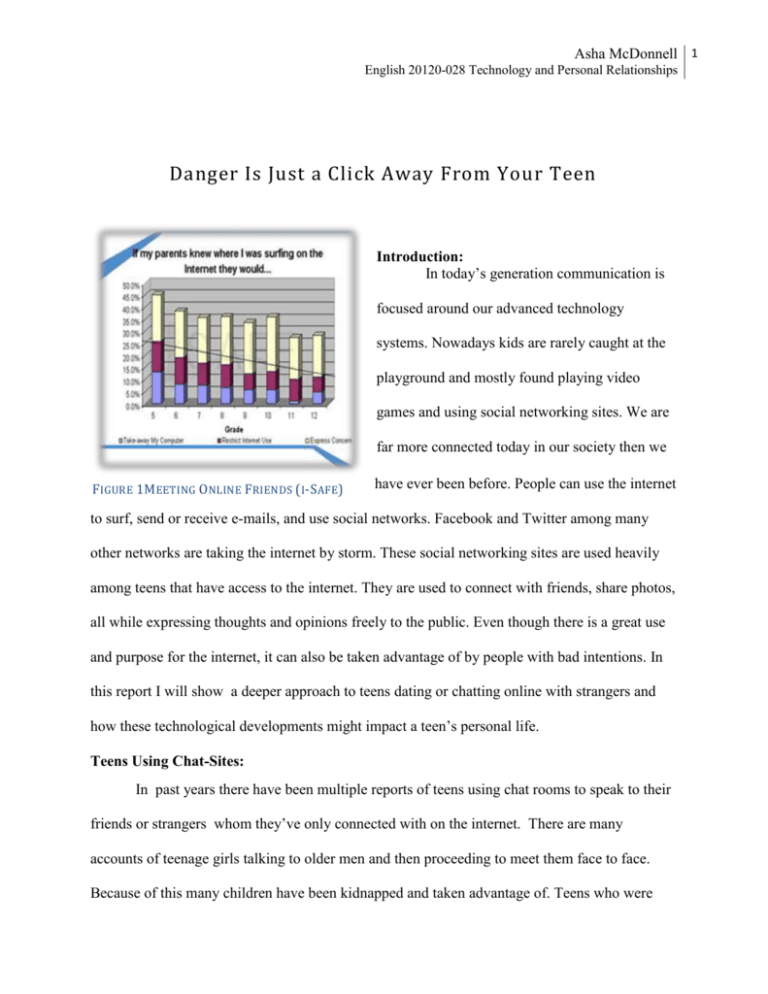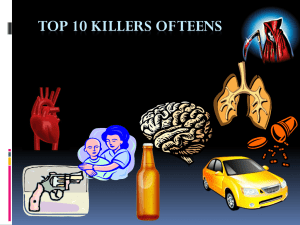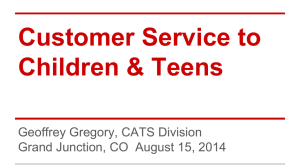
Asha McDonnell 1
English 20120-028 Technology and Personal Relationships
Danger Is Just a Click Away From Your Teen
Introduction:
In today’s generation communication is
focused around our advanced technology
systems. Nowadays kids are rarely caught at the
playground and mostly found playing video
games and using social networking sites. We are
far more connected today in our society then we
FIGURE 1M EETING ONLINE FRIENDS ( I-SAFE)
have ever been before. People can use the internet
to surf, send or receive e-mails, and use social networks. Facebook and Twitter among many
other networks are taking the internet by storm. These social networking sites are used heavily
among teens that have access to the internet. They are used to connect with friends, share photos,
all while expressing thoughts and opinions freely to the public. Even though there is a great use
and purpose for the internet, it can also be taken advantage of by people with bad intentions. In
this report I will show a deeper approach to teens dating or chatting online with strangers and
how these technological developments might impact a teen’s personal life.
Teens Using Chat-Sites:
In past years there have been multiple reports of teens using chat rooms to speak to their
friends or strangers whom they’ve only connected with on the internet. There are many
accounts of teenage girls talking to older men and then proceeding to meet them face to face.
Because of this many children have been kidnapped and taken advantage of. Teens who were
Asha McDonnell 2
English 20120-028 Technology and Personal Relationships
involved in a relationship with an online predator were being lied to about the age of the predator
in an attempt to take advantage of them. Even though this still may be true in some situations;
nowadays predators are taking a whole new approach to online chatting. According to “Cyber,
Psychology, Behavior, and Social Networking” the majority of predators online are openly
speaking about their age and intentions to teens and it is the teens who are responding to the
predators about their sexual desires. ).
Of course teenagers aren’t going to tell their parents that they are chatting online with
strangers, which makes this issue extremely difficult to control. This just proves that although
teens might be at home safe, danger is only a click away. Recent studies have shown that kids are
using the internet up to 10 hours a day duringI which they are likely unmonitored while online
(McCarty 196). This extensive use of the internet allows teens to share personal and false
information with complete strangers every day.
Risky Chat-Site Behaviors:
There are a few methods that Cheryl McCarty listed in her article “Perceived Safety and
Teen Risk Taken in Online Chat Sites”. McCarty states that “adolescent development provides a
basis for understanding the seeming unwillingness of youth to use online chat-site security
measures” (McCarty 170). Meaning McCarty recognizes that teens are unwilling to take the
safety precautions needed to insure that they are protected while using the internet. These safety
precautions can be as simple as using pop up blocks and respecting sites that are banned by
computer. She goes on to explain how children go through four stages of cognitive development
and at age 12 the formal operation thought process begins. “This is where the ability to think
abstractly unfolds and adolescents begin to explore various aspects of situations while creating a
solution to a problem”.
Asha McDonnell 3
English 20120-028 Technology and Personal Relationships
Teens are able to analyze the safety of the chat-site environment, but due to a lack of
reasoning, misjudgments are often made and the curiosity of a teen can overshadow a smart
decision about a dangerous site. There are also many other factors of the cognitive development
stage that come into play as well as having a lack of identity. Among many other things
adolescents do not have a strong identity about themselves which causes them to explore
different roles in life, experimenting online, and creating different personalities for themselves.
When teens hide behind a computer, they are more likely pretending to be someone who they
are not, in an attempt to structure who they think they are or should be (McCarty, 170).
Statistics about Teens and Online Dating:
One in five U.S. teenagers who regularly log on to the Internet says they have received an
unwanted sexual solicitation via the Web. Solicitations were defined as requests to
engage in sexual activities or sexual talk, or to give personal sexual information.
25% of children have been exposed to unwanted pornographic material online.
Only 1/3 of households with Internet access are actively protecting their children with
filtering or blocking software.
75% of children are willing to share personal information online about themselves and
their family in exchange for goods and services.
Only approximately 25% of children who encountered a sexual approach or solicitation
told a parent or adult.
One in 33 youth received an aggressive sexual solicitation in the past year. This means a
predator asked a young person to meet somewhere, called a young person on the phone,
and/or sent the young person correspondence, money, or gifts through the U.S. Postal
Service.
77% of the targets for online predators were age 14 or older. Another 22% were users
ages 10 to 13.
Asha McDonnell 4
English 20120-028 Technology and Personal Relationships
Figure 2 Meeting Online Friends (I Safe)Protecting Teens:
Okay; parents here is where it gets tricky. Sometimes it gets hard when dealing with
teens, but necessary precautions should be taken to insure that teens are being smart and safe
when chatting online. If you noticed when reading the statistics, 75% of teens tend to divulge
personal information about them-selves. The first thing we can do to protect our teens is to
communicate the importance of withholding personal information. Another tip given by David
Lee who is the writer of Online Dating for Teenagers: A Safety Guide For Parents, says that
parents should suggest to their teens not to get overly invested in their online relationship until
their online partner’s true identity is revealed by having a face to face meeting. Besides the
parent and teen communication there are always ways to protect teens through technology. Karen
Diro, writer of “Parental Controls Basics” says that there are many parental blocks that can
prevent practically anyone from using certain websites. In her blog she gave a few internet
software reviews. Obviously teens don’t have to meet predators on chat sites; they can also be
using major social networking sites, as stated previously, like Face Book. In those situations
David Lee suggest that teens be designated a time limit to their computer use. This suggestion
Asha McDonnell 5
English 20120-028 Technology and Personal Relationships
won’t keep teens from meeting strangers online, but it will be able to monitor how much time
they are chatting online. Every little step helps!
Speaking to the Community:
Understanding teens and their actions is almost impossible sometimes, but understanding
technology and controlling it is something that would be considered as an easier task. Every year
hundreds of teens make irrational decisions such as meeting a stranger face to face that they have
met online without notifying an adult. Often in times those decisions result in kidnap, murder or
even sexual assault. Bringing awareness to various communities will help expose online
predators as well as informing teens about those dangers and risks. Information about this issue
is everywhere including different online informative sites as well as TV shows. On MSBNBC
Chris Hansen is the host for To Catch A Predator. This show is a useful aid for letting parent and
teens know what to look out for when using online chat sites. Remember technology is not the
problem; it’s what you do with it that that decides the outcome of our situation.
Asha McDonnell 6
English 20120-028 Technology and Personal Relationships
Bibliography:
Cheryl, McCarty. “Perceived Safety and Teen Risk Taking in Online Chat Sites”. Cyber
Psycology, Behavior, and Social Networking. 14.3 (2011): 169-174. Academic
Search Premier. Web. 22, June 2012.
David Lee. “Online Dating for Teenagers”: A Safety Guide For Parents. Living Strong.
Pub. Nov 17, 2009. Article. Web. June 24, 2012.
i-Safe. The Leader in e-Safety Education. Learning the 4 R’s; Students and meeting online
friends. 1998-2012 i-SAFE Inc. Web.
Karen Diro. “Parental Controls Basics”. Safety Clicks. Internet Software reviews. Pub.
July 23rd 2008 10:30AM. Par. 1-3. Web. Article. June 25, 2012.








